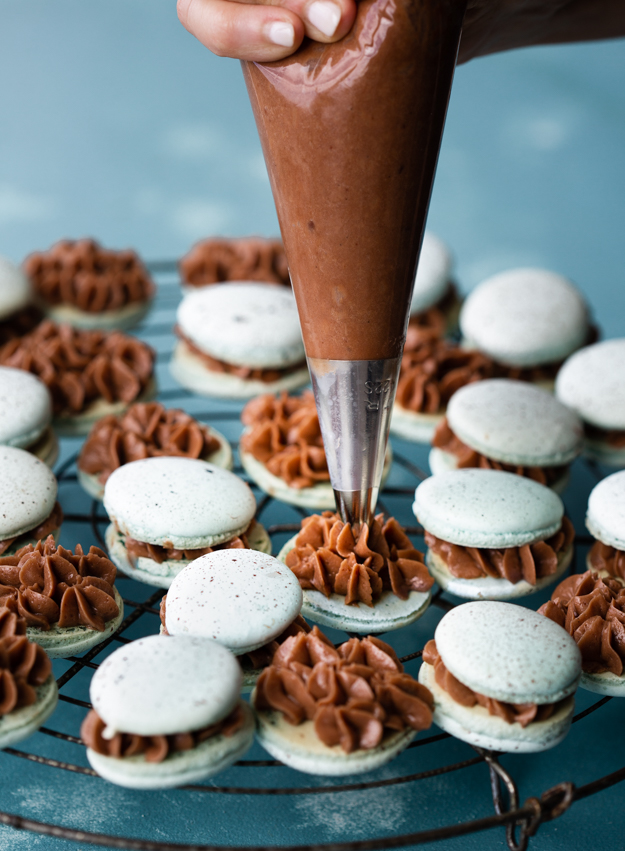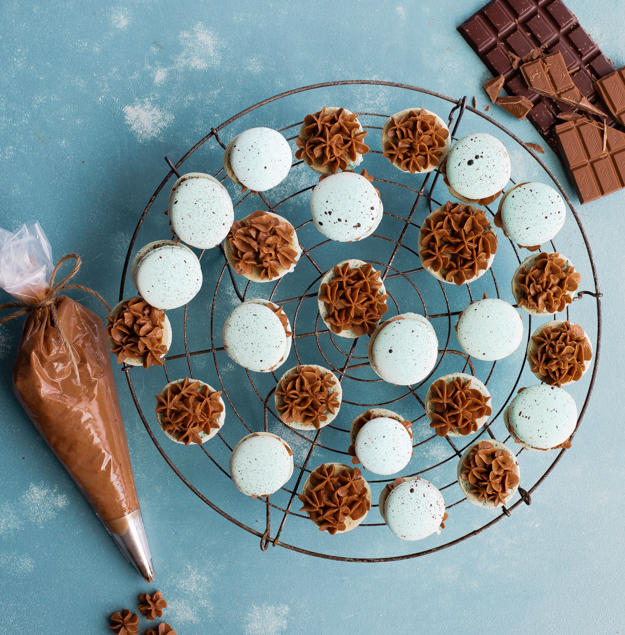
Macarons (not to be confused with macaroons) have a reputation for being difficult to make. Essentially, a macaron is made from ground almonds, powdered sugar and egg whites. Seems simple enough but so much can go wrong. They are a tricky little cookie. If you overmix, or undermix, fail to measure correctly, overbake or underbake you won’t get the pretty frilly “feet” or smooth surface. You need to pay attention to every step of the process. The best way to become proficient at macaron making is to make them often. Since I only make macarons once a year, at Passover, I have not become proficient.
Some years they turn out perfectly, other years, they are cracked and hollow. They always taste delicious, no one complains and they all get eaten, but it bothered me that I couldn’t get consistent results. I am in charge of desserts at our family Passover Seders. That’s dessert for 45 people on the first night at my sister-in-law’s house (my husband’s side of the family) and 36 guests at my mom’s house on the second night.

As I was planning what to bake and going through my cookbooks for inspiration, I noticed a little book on my shelf titled, “Secrets of Macarons”. I think it was a gift, but I had never read it. I was curious to see what French chef, Jose Marechal, had to say about this little diva of a cookie.
I made a startling discovery. Apparently there are two methods by which macarons can be created, the French meringue method and the Italian meringue method. In the Italian method, the sugar is boiled into a syrup, and once it reaches 240°F, it is carefully incorporated into the egg whites. In the French method, the raw sugar is added into the egg whites. I had only ever tried the French method. While on the surface it would seem that the French method is simpler, no dealing with candy thermometers and boiling hot syrup, you need to consider the benefits of that extra step of boiling the sugar. Cooking the sugar into a syrup creates a more stable macaron batter.
Marechal explains the science behind the Italian method. “Since the sugar is incorporated in the form of a syrup, it disperses into the beaten egg whites well, puffing them up while evaporating some moisture. Since the Italian meringue has a denser consistency, it is easier to incorporate into the almond paste. It has a less brittle structure and the macaronage (working the batter) is more manageable.”
I was curious to see if the Italian meringue method would give me more consistent results. I made 6 batches of macarons over 2 days. (Two batches each of these Robin’s Egg, two batches of salted caramel macarons and two batches of PB&J macarons). Every batch came out almost perfectly. No hollow shells, no cracked tops and lovely frilly feet.
Although the Italian method involves the additional step of cooking the sugar, the consistent results are worth it. If you’re a macaron newbie, take the extra step and boil your sugar. You’ll thank me!


Great post, Cindy, and thanks for explaining the difference between the French and Italian methods! A couple of years ago my very first try at (French) macarons went very well, and I got quite cocky thinking it was all so easy. All my following results were – as yours – very inconsistent. It was never one same thing that didn’t go right, it was always something different. I’ll definitely give the Italian method a try to see if I can be as successful as you. Your robin egg macarons look beautiful!
Thanks Kiki! Using the Italian method was really a game changer for me. Let me know what you think if you try it!